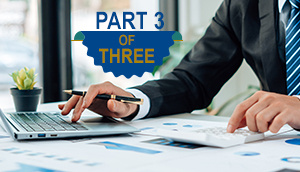
The vast majority of businesses in the United states are classified as Small Businesses under standards of the Small Business Administration (SBA). Deteriorating economic conditions that are a result of the Covid-19 pandemic are causing severe financial hardship to contractors and small businesses, and many are wondering if they will survive. In the midst of these business struggles, there are significant financial benefits that have become available. Part of the Coronavirus Aid, Relief, and Economic Security (CARES) Act that was just signed into law on Friday, March 27 includes $349 billion of funding for the Paycheck Protection Program (PPP). Under the PPP, many small businesses could qualify for an SBA guaranteed loan to help them maintain payroll during these tough economic times.
A tremendous feature of PPP loans is that they are fully forgivable if certain conditions are met. Details of the PPP may be found on the US Senate Committee on Small Business and Entrepreneurship’s website.
Being so beneficial to such a large number of small businesses in the United States, contacting an SBA-approved lender as soon as possible may help you avoid delays if the volume of loan applications puts a strain on lenders’ capacity to process PPP loans. You can apply through any existing SBA 7(a) lender or through any federally insured depository institution, federally insured credit union, and Farm Credit System institution that is participating. Other regulated lenders will be available to make these loans once they are approved and enrolled in the program. You should consult with your local lender as to whether it is participating in the program.
Here are a few links that could be helpful for you and your contractors as they navigate through this process. As well, we are sharing some information received from SFAA regarding the loan program.
Sample Loan Application (Your lender may have a different application for you).
CARES Act Resource Page - US Treasury
Treasury Department CARES Act Fact Sheet
Information from SFAA to Board Members and Bonding Officers:
I am reaching out to provide resources to guide your small business contractor clients step by step through the new Small Business Administration’s (SBA) loan program, known as the Paycheck Protection Program (PPP loans). As a reminder, last week Congress approved a $2 Trillion legislative package (CARES Act) that included provisions to allocate $350 billion for federally-backed loans to support U.S. companies with less then 500 employees. The Paycheck Protection Program included as part of the legislative stimulus signed into law last week, is separate from the SBA program’s Economic Injury Disaster Loans (EIDL), which has been available for companies experiencing financial hardship as a result of COVID-19 since early March.
Step-by-Step Guidance
The U.S. Chamber of Commerce has created a thorough walk-through to help U.S. businesses determine if they are eligible to receive a small business loan, linked here, and also included at the bottom of this email. Importantly, this step-by-step guidance provides:
- Who is eligible for these loans
- What lenders will be looking for in the application process
- How many companies are allowed to borrow
- How to seek loan forgiveness
Companies still interested in applying for disaster relief loans (EIDL) can find further resources here; however, SBA guidance is directing potential new applicants to the PPP loan portal. Additionally, we included some frequently asked questions and answers below to address some of the top concerns small business owners have raised as they navigate the options available to them through the SBA loan programs. For real-time updates from the Chamber of Commerce, including additional information on which lenders are participating in the program, please click here. If your small business contractor clients need real-time help with a representative of the SBA, please click here to find the closest SBA district office.
Brief FAQ for Small Business Entities Interested in Taking Next Steps to Apply for a Loan - (courtesy of SFAA):
Where can I apply for the Paycheck Protection Program?
You can apply for the Paycheck Protection Program (PPP) at any lending institution that is approved to participate in the program through the existing U.S. Small Business Administration (SBA) 7(a) lending program and additional lenders approved by the Department of Treasury. This could be the bank you already use or a nearby bank. There are thousands of banks that already participate in the SBA's lending programs, including numerous community banks. You do not have to visit any government institution to apply for the program. You can call your bank or find SBA-approved lenders in your area through SBA's online Lender Match tool.
If I have applied for or received an Economic Injury Disaster Loan (EIDL) related to the COVID-19 virus before the Paycheck Protection Program became available, will I be able to refinance into a PPP loan?
Yes. If you received an EIDL loan related to the virus between January 31, 2020, and the date at which the PPP becomes available, you would be able to refinance the EIDL into the PPP for loan forgiveness purposes. However, you may not take out an EIDL and a PPP for the same purposes. Remaining portions of the EIDL, for purposes other than those laid out in loan forgiveness terms for a PPP loan, would remain a loan. If you took advantage of an emergency EIDL grant award of up to $10,000, that amount would be subtracted from the amount forgiven under PPP.
I am an independent contractor or gig economy worker, am I eligible?
Yes. Sole proprietors, independent contractors, gig economy workers, and self-employed individuals are all eligible for the Paycheck Protection Program.
When is the application deadline for the Paycheck Protection Program?
Applicants are eligible to apply for the PPP loan until June 30th, 2020.
What is the maximum amount I can borrow?
The amount any small business is eligible to borrow is 250 percent of their average monthly payroll expenses, up to a total of $10 million. This amount is intended to cover 8 weeks of payroll expenses and any additional amounts for making payments towards debt obligations. This 8 week period may be applied to any time frame between February 15, 2020, and June 30, 2020. Seasonal business expenses will be measured using a 12-week period beginning February 15, 2019, or March 1, 2019, whichever the seasonal employer chooses.
How can I use the money such that the loan will be forgiven and when is the loan forgiven?
The amount of principal that may be forgiven is equal to the sum of expenses for payroll, and existing interest payments on mortgages, rent payments, leases, and utility service agreements. Payroll costs include employee salaries (up to an annual rate of pay of $100,000), hourly wages and cash tips, paid sick or medical leave, and group health insurance premiums. If you would like to use the Paycheck Protection Program for other business-related expenses, like inventory, you can, but that portion of the loan will not be forgiven. The loan is forgiven at the end of the 8-week period after you take out the loan. Borrowers will work with lenders to verify covered expenses and the proper amount of forgiveness. If you have already laid off some employees, you can still be forgiven for the full amount of your payroll cost if you rehire your employees by June 30, 2020. If the full principal of the PPP loan is forgiven, the borrower is not responsible for the interest accrued in the 8-week covered period. The remainder of the loan that is not forgiven will operate according to the loan terms agreed upon by you and the lender.
What is the covered period of the loan?
The covered period during which expenses can be forgiven extends from February 15, 2020 to June 30, 2020. Borrowers can choose which 8 weeks they want to count towards the covered period, which can start as early as February 15, 2020.
When can we expect further guidance from the SBA on this new program?
The SBA has until April 10, 2020, to issue regulations implementing this new program. That rulemaking will not be subject to typical public notice and comment processes. The SBA also has until April 26, 2020, to issue specific guidance on loan payment deferment relief and the loan forgiveness provisions.
Old Republic Surety is committed to helping our agents and their contractors, principals and small businesses navigate through these tough times. We encourage you to connect with your local branch underwriters for further information and assistance. We are here for you.
Related: SBA Surety Bond Guarantee Program
Topics

Since 1999, Mike Sanders, bond manager, has overseen the underwriting and operations of the Milwaukee Contract Branch office. From 1992 until 1999, Mike held responsibilities in another of our large branch offices, working with both contract surety and commercial bond business. Mike launched his surety career with Aetna Casualty and Surety Company, where he handled the marketing and underwriting of all lines of bond business. Mike holds a bachelor’s degree in finance from Drake University and has an Associate in Fidelity and Surety Bonding (AFSB) designation.


